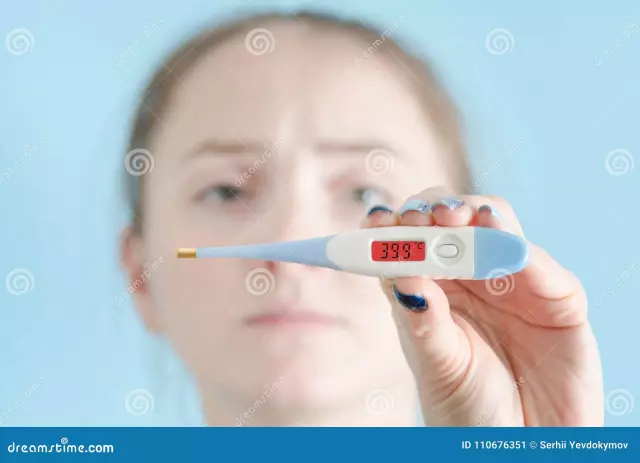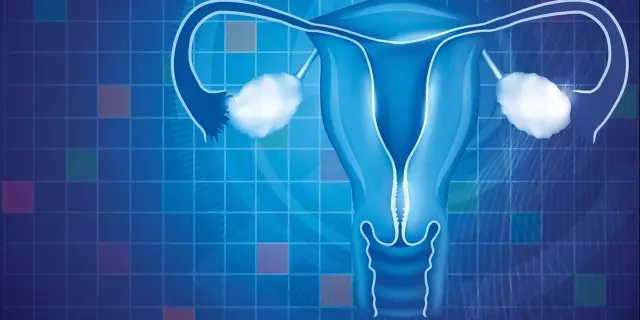- Author Rachel Wainwright [email protected].
- Public 2023-12-15 07:39.
- Last modified 2025-11-02 20:14.
17-OH-progesterone - what is it?
The content of the article:
- 17-OH-progesterone rate
- Blood test for hormone content
- Causes of increased and decreased 17-OH-progesterone
- Symptoms of high and low 17-OH-progesterone levels
- Correction of the hormone 17-OH-progesterone
17-OH-progesterone (17-hydroxyprogesterone) is a steroid hormone, a minor progestin, which is produced by the corpus luteum of the ovaries and the adrenal cortex. 17-OH-progesterone is formed from progesterone and 17-hydroxypregnenolone. This hormone differs from progesterone by the presence of an additional hydroxyl radical (OH) at the 17th carbon atom in the steroid skeleton.
17-OH-progesterone is an intermediate in the synthesis of cortisol and some other hormones in the adrenal glands. When a person is in fear or danger, 17-hydroxyprogesterone promotes blood flow to the heart and muscles. In a state of stress, it is also responsible for burning muscle mass, arterial hypertension, arrhythmia.
The hormone serves as one of the regulators of reproductive function, affects a woman's ability to conceive and bear a child. In the case of successful implantation of a fertilized egg, the concentration of the hormone in the blood increases. A large amount of 17-OH-progesterone is produced by the placenta during pregnancy (hormone production increases significantly by the third trimester of pregnancy and sharply decreases several days before delivery). If fertilization has not occurred, the level of the hormone will decrease again by the beginning of the folliculin phase of the next menstrual cycle. 17-hydroxyprogesterone can also metabolize the main male sex hormone testosterone.

The content of 17-OH-progesterone in the blood increases with fear, stress, anger
The concentration of 17-OH-progesterone in the blood depends on the time of day; therefore, its level is measured taking into account daily fluctuations. The highest concentration of 17-hydroxyprogesterone in the blood is observed in the morning (after 09:00). In addition, the content of the hormone varies with age, and in women, with the phase of the menstrual cycle. The level of 17-OH-progesterone increases slightly towards the middle of the menstrual cycle and does not change during the luteal phase. In a normal state, the amount of the hormone in the blood is negligible.
17-OH-progesterone rate
The normal amount of the hormone differs between men and women. The norm of 17-OH-progesterone in women, depending on the phase of the menstrual cycle, is:
- in the follicular phase - 1.25-8.25 nmol / l;
- in the middle of the cycle - 0.9-4.25 nmol / l;
- in the luteal phase - 1.0-11.5 nmol / L.
In pregnant women:
- in the first and second trimester - 3.55-20.0 nmol / l;
- in the third trimester - 3.75-33.3 nmol / l.
In men, the content of 17-hydroxyprogesterone in the blood is normally 1.5-6.35 nmol / l.
In different laboratories, the norms may differ depending on the research method and the adopted units of measurement.
Blood test for hormone content
Blood sampling for analysis for 17-OH-progesterone in women is usually carried out on the third to fifth day of the cycle. To obtain a reliable result for the study, you need to properly prepare. You need to donate blood in the morning on an empty stomach, before that it is allowed to use water, but no more than two glasses.
Laboratory determination of the concentration of 17-hydroxyprogesterone is prescribed for the following indications:
- planning pregnancy;
- menstrual irregularities;
- infertility in women;
- miscarriage;
- hirsutism;
- intermenstrual uterine bleeding;
- soreness of the mammary glands;
- severe premenstrual syndrome;
- suspicion of hyperplasia of the adrenal cortex;
- checking the effectiveness of the treatment for adrenal diseases.
Since an increase in the level of this hormone may be due to physiological reasons (for example, pregnancy), an exercise test and genetic testing may be required to confirm the pathological process.
In some cases, additional determination of the concentration of other hormones (progesterone, estradiol, luteinizing and follicle-stimulating hormone) may be required.
In addition, a set of diagnostic measures may include ultrasound examination of the adrenal glands, abdominal and pelvic organs, computed and / or magnetic resonance imaging, radionuclide research methods, etc.
Causes of increased and decreased 17-OH-progesterone
A reduced concentration of 17-OH-progesterone is observed with the following pathologies:
- pseudohermaphroditism in men (impaired male body formation caused by impaired progesterone production);
- congenital or acquired adrenal insufficiency;
- Addison's disease (hypocorticism).
Physiologically, the level of 17-OH-progesterone rises in stressful situations, when experiencing fear, anger, mental strain.
A pathological increase in the concentration of 17-hydroxyprogesterone in the blood is observed with congenital adrenal hyperplasia due to a deficiency of the enzyme 21-hydroxylase (the most common disease from the group of steroidogenesis disorders). Usually, 17-OH-progesterone is elevated in adrenal and ovarian neoplasms, polycystic ovary syndrome, and menstrual irregularities. In addition, reasons for the increase include taking progesterone-based medications, fasting, or following a strict diet.
Symptoms of high and low 17-OH-progesterone levels
Signs of increased levels of 17-OH-progesterone in the blood:
- violation of the menstrual cycle;
- excess growth and thinning hair;
- changes in the concentration of glucose in the blood;
- acne;
- susceptibility to infectious diseases.
In the absence of timely correction, the patient develops arterial hypertension, insulin resistance, diabetes mellitus, cholesterolemia, atherosclerosis, pathologies of the cardiovascular system. A prolonged increase in the concentration of this hormone can lead to the development of mental disorders, depressive conditions, the formation of ulcers of the gastrointestinal tract, and impaired cerebral circulation. Frequent episodes of an increase in the level of 17-OH-progesterone negatively affect the state of the brain tissue and can lead to the development of encephalopathy.
A sign of low hormone levels is darkening of the skin, especially in natural folds.
Correction of the hormone 17-OH-progesterone
Methods for correcting the amount of the hormone 17-OH-progesterone in the blood depend on the cause that caused the development of the pathological condition.
Self-medication, especially with the use of pharmacological drugs, with an increase or decrease in 17-hydroxyprogesterone is unacceptable, since it has a high risk of complications. The use of any drugs for this pathology is carried out strictly under medical supervision.
Drug therapy for elevated hormone usually includes the administration of glucocorticosteroids. To reduce the level of 17-OH-progesterone, which increased against the background of organic changes (for example, due to tumor processes), a combined surgical and drug treatment is used to eliminate the root cause and then normalize the hormonal background.
With elevated 17-hydroxyprogesterone, a diet enriched with vitamins is necessary. The daily diet includes fruits and vegetables high in vitamin C (lemon, currants, kiwi, cabbage, bell peppers, rose hips, etc.), green tea, coffee, dried fruits, potatoes, carrots, onions, parsley, beets, peas. At the same time, limit the use of protein foods.

For elevated 17-hydroxyprogesterone levels, a vitamin C-fortified diet is recommended
The normalization of lowered 17-hydroxyprogesterone is carried out using hormone replacement therapy with progesterone drugs. Treatment with pure progesterone (given by intramuscular injection) usually lasts about ten days.
YouTube video related to the article:

Anna Aksenova Medical journalist About the author
Education: 2004-2007 "First Kiev Medical College" specialty "Laboratory Diagnostics".
Found a mistake in the text? Select it and press Ctrl + Enter.






